
State of Texas
Assessments of
Academic Readiness
STAAR
®
Biology
Administered May 2015
RELEASED
Copyright © 2015, Texas Education Agency. All rights reserved. Reproduction of all or portions of this work is prohibited without express
written permission from the Texas Education Agency.
Biology
Page 3
Page 4

DIRECTIONS
Read each question carefully. Determine the best answer to the question from the four
answer choices provided. Then fill in the answer on your answer document.
1 In the European roe deer (Capreolus capreolus), implantation of embryos after breeding is
delayed. The deer breed in July or August but do not give birth until the following May or
June. From summer to late December, the embryo rests in a state of dormancy as a 30-cell
blastocyst. In late December or early January, the embryo sends a signal that causes the
female to release hormones, allowing the embryo to continue to develop normally.
Page 5
Roe Deer Fawn
© iStockphoto.com/Karel Broz
Why is delayed implantation an advantageous adaptation for the European roe deer?
A Delayed implantation allows the mother to continue to breed with other males.
B Without delayed implantation, the females would not be able to carry a pregnancy to
full term.
C Delayed implantation enables the female to give birth to more fawns each year.
D Without delayed implantation, the fawns would be born in the winter when food is
scarce and the weather is harsh.
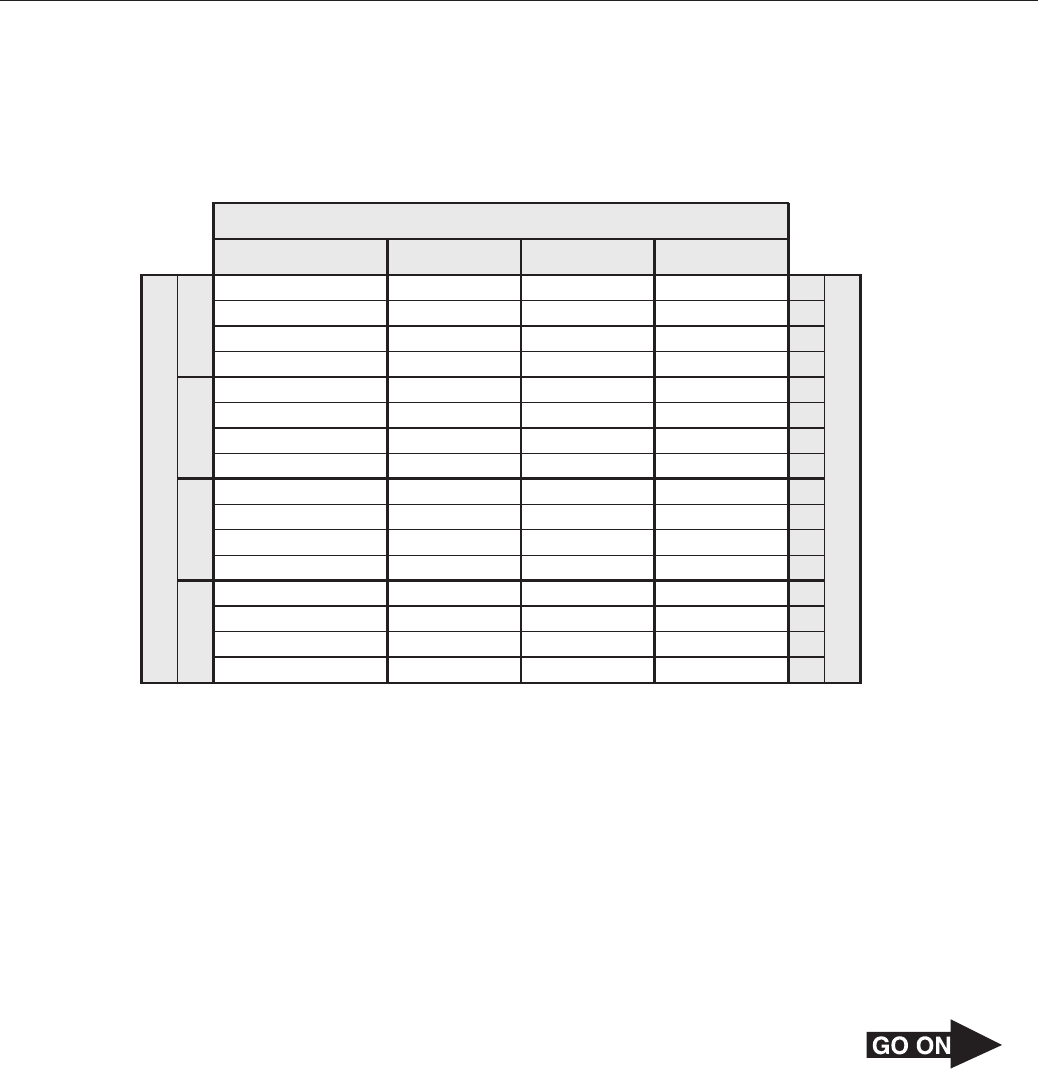
Page 6
2 Parrotfish are herbivores that are found in coral reefs. To escape predation, a parrotfish will
graze with a rabbitfish, which has venomous spines at the end of its pelvic fins. The rabbitfish
does not benefit from this relationship. Which type of relationship do the parrotfish and the
rabbitfish have in the coral-reef environment?
F Commensal
G Mutualistic
H Predator–prey
J Parasitic
3 A segment of DNA produces methionine, threonine, histidine, aspartate, and glycine when
translated. A substitution mutation occurs and causes the synthesis of the segment as shown.
First Letter
Serine
Serine
Serine
Serine
Proline
Proline
Proline
Proline
Threonine
Threonine
Threonine
Threonine
Alanine
Alanine
Alanine
Alanine
C
Second Letter
Phenylalanine
Phenylalanine
Leucine
Leucine
Leucine
Leucine
Leucine
Leucine
Isoleucine
Isoleucine
Isoleucine
Methionine (START)
Valine
Valine
Valine
Valine
U
Tyrosine
Tyrosine
(STOP)
(STOP)
Histidine
Histidine
Glutamine
Glutamine
Asparagine
Asparagine
Lysine
Lysine
Aspartate
Aspartate
Glutamate
Glutamate
A
Cysteine
Cysteine
(STOP)
Tryptophan
Arginine
Arginine
Arginine
Arginine
Serine
Serine
Arginine
Arginine
Glycine
Glycine
Glycine
Glycine
G
U
C
A
G
Third Letter
U
C
A
G
U
C
A
G
U
C
A
G
U
C
A
G
New DNA strand: 3’-TACAGGGTGCTACCCACT-5’
Codon Chart
Which is the new peptide chain when the new DNA segment is translated?
A Methionine, leucine, histidine, aspartate, glycine
B Methionine, phenylalanine, histidine, aspartate, glycine
C Methionine, proline, histidine, aspartate, glycine
D Methionine, serine, histidine, aspartate, glycine

Page 7
4 As ecosystems move through the stages of succession, the populations of organisms in them
change. Which of the following describes the stage of succession likely to have the most
species diversity?
F A newly formed volcanic island
G An agricultural field that has not been plowed for one year
H A temperate forest that has never been cleared by logging
J A field that is regularly mowed
5 Frogs and toads belong to the order Anura. The smallest organism in this order is about
7 millimeters long, while the largest member is about 30 centimeters long. Which of these
lists best describes this order?
A
• 338 families
• 28 genera
• 4,360 species
Order Anura
B
• 28 families
• 338 genera
• 4,360 species
Order Anura
C
• 338 families
• 4,360 genera
• 28 species
Order Anura
D
• 28 families
• 4,360 genera
• 338 species
Order Anura

Page 8
6 On March 24, 1989, an oil tanker ran aground on Bligh Reef in Prince William Sound, Alaska,
and spilled millions of liters of crude oil. The graph shows pink salmon populations in Prince
William Sound from 1970 to 1999.
50
40
30
20
10
0
1970
1971
1972
1973
1974
1975
1976
1977
1978
1979
1980
1981
1982
1983
1984
1985
1986
1987
1988
1989
1990
1991
1992
1993
1994
1995
1996
1997
1998
1999
Year
Number of Fish (millions)
Pink Salmon Populations in Prince William Sound, 1970–1999
Source: Alaska Department of Fish and Game
What do these data suggest about the effect the oil spill had on pink salmon?
F Pink salmon were nearly eliminated after the oil spill.
G Pink salmon populations steadily declined in the 10 years following the spill.
H Pink salmon populations declined and never fully recovered.
J Pink salmon populations seemed to be minimally affected.
7 Cells typically respond to DNA damage in three ways: by ceasing to grow and divide until
the damage is repaired, by permanently ceasing to grow and divide, or by dying. In 2010 a
group of scientists reported that a certain kind of immune reaction can cause DNA damage
that leads to a fourth response. DNA damage can turn off genes involved in cell-signaling
pathways. Turning off these genes can cause less-mature cells to divide too rapidly, often
leading to the development of —
A tumors
B allergies
C hemophilia
D cardiovascular disease

Page 9
8 In recent years humans have interfered with the natural balance within deer populations in
various ecosystems. The interference includes eliminating predators of the deer. Which of the
following statements correctly describes the long-term outcome of this interference?
F The deer that are the fastest and most agile will survive and reproduce.
G The deer population will be too large to be supported by producers.
H Other browsing species will thrive and outcompete the deer.
J The producers will evolve into species that are less palatable to the deer.
9 A student wants to use the Venn diagram below to show the characteristics of two kingdoms
of organisms. The characteristics that the two kingdoms share will be listed in the shaded
area where the circles intersect.
Kingdom
Fungi
Kingdom
Plantae
Which of these is a characteristic that the student should list in the shaded part of the
diagram?
A Heterotrophic C Prokaryotic
B Mobile D Multicellular

Page 10
10 Part of an important cellular process involving a DNA strand is modeled below.
3’ 5’
5’
3’
What is the purpose of this cellular process?
F Preserving genetic information for future generations
G Deleting the information in the sequence produced from the DNA template
H Transcribing information in the DNA sequence for use by the cell
J Producing more nucleotides for the DNA sequence

Page 11
11 A student preparing for a hike wants to pack a snack that has biomolecules that provide
quickly available energy but few excess calories. Which nutrition label lists the best
combination of biomolecules that provide quickly available energy while providing the fewest
calories from other types of biomolecules?
A
Nutrition Facts
Serving Size: 1 Tbsp (6g)
Amount Per Serving
Calories: 20
Total Fat 0g
Cholesterol 0mg
Sodium 60mg
Potassium
Protein 5g
Total Carbohydrate 0g
Saturated Fat 0g
Trans Fat 0g
Dietary Fiber 0g
Sugars 0g
0%
0%
0%
2%
0%
0%
Calories from Fat 0
% Daily Value*
B
Nutrition Facts
Serving Size: 1 package (50g)
Amount Per Serving
Calories: 180
Total Fat 8g
Cholesterol 0mg
Sodium 55mg
Protein 15g
Total Carbohydrate 13g
Saturated Fat 1g
Fiber 1g
Sugars 9g
13%
5%
0%
2%
5%
Calories from Fat 75
% Daily Value*
C
Nutrition Facts
Serving Size: 1 cup (250g)
Amount Per Serving
Calories: 975
Total Fat 83.5g
Cholesterol 65mg
Sodium 1775mg
Potassium 22.5mg
Protein 2.25g
Total Carbohydrate 59.5g
Saturated Fat 12.25g
Trans Fat
Dietary Fiber 0.25g
Sugars 50.28g
128%
61%
22%
74%
1%
20%
1%
Calories from Fat 752
% Daily Value*
D
Nutrition Facts
Serving Size: 1 bar
Amount Per Serving
Calories: 140
Total Fat 4g
Cholesterol 0mg
Sodium 90mg
Protein 5g
Total Carbohydrate 22g
Trans Fat 1g
Dietary Fiber 2g
Sugars 10g
6%
0%
0%
4%
7%
10%
8%
Calories from Fat 40
% Daily Value*
Saturated Fat 1g
5%

Page 12
12 Organisms can be classified based on homology, which is shared characteristics inherited from
a common ancestor. In the past, homologies were based on studies of anatomical structures
and patterns of embryonic development. In more recent years, the use of molecular biology
techniques has allowed homologies to be compared at the level of nucleotide sequences.
Nucleotide sequence comparisons are possible because all organisms share which of the
following?
F DNA bases
G Cellular organelles
H Division of the nuclear chromosomes
J Types of proteins needed for cellular functions
13 An informational pamphlet in a health clinic describes an interaction between body systems.
An ovum moves from an ovary into the
uterine tube where its migration toward
the uterus is aided by the peristaltic
contractions of the smooth tissues of the
uterine tube’s walls.
Which statement identifies the body systems that are directly involved in the interaction
described and explains how they accomplish the interaction?
A The nervous system produces hormones that stimulate the ovum, and the circulatory
system moves the ovum into the uterine tube.
B The circulatory system supplies the uterine wall with oxygenated blood, and the
immune system prevents damage to the ovum.
C The reproductive system produces the ovum, and the muscular system causes the
migration of the ovum by peristaltic contractions.
D The excretory system expels the ovum from the ovary, and the nervous system causes
the contractions of the smooth tissues of the uterine wall.

Page 13
14 Models of the human immunodeficiency virus (HIV) and an animal cell are shown below.
Glycoprotein
HIV Virion Animal Cell
Cilia
Not drawn to scale
What is the difference in the function of the glycoprotein structures of an HIV virion and the
cilia of an animal cell?
F The glycoprotein structures are used for attachment, and the cilia are used to move
fluids surrounding the cell.
G The glycoprotein structures are used to obtain nutrition, and the cilia are used to
secrete proteins.
H The glycoprotein structures are used to provide physical support for the viral envelope,
and the cilia strengthen the cell membrane.
J The glycoprotein structures are used for defense, and the cilia are used for locomotion.
15 Diatoms are one of the most common types of phytoplankton in marine habitats. Like plants,
diatoms contain chlorophyll and produce glucose from which of the following?
A O and ATP
2
B CO and O
2 2
C ATP and H O
2
D CO and H O
2 2

Page 14
16 A genome-wide association study involves searching the genomes of many people in order
to find genetic variations associated with common diseases such as cancer, asthma, and
diabetes. These studies are possible because of computer databases that allow researchers
to compare the genomes of people who do not have a particular condition with the genomes
of people who have the condition. In order to do this type of testing, researchers need blood
samples or cheek swabs from people. Obtaining these samples is necessary because blood
and cheek cells contain —
F plasma and platelets
G a complete set of DNA
H essential proteins and amino acids
J a large number of neutrophils
17 When the level of carbon dioxide in the blood is too high, the excess carbon dioxide reacts
with water and produces carbonic acid. The carbonic acid causes the blood pH to become
more acidic. When the blood pH becomes too acidic, chemoreceptors in the brain instruct the
body to react and maintain homeostasis in blood pH. Which of these responses by the body
would eliminate the excess carbon dioxide and help maintain homeostasis in blood pH?
A Increasing the body temperature by shivering
B Increasing glucose levels in the blood
C Breathing more deeply and frequently
D Decreasing the heart rate

Page 15
18 Two populations of mice living in the same forest are separated by a large water-filled ditch.
After a rainstorm, flooding brings several mice from one population to the other population.
When the mice from the first population reproduce with members of the second population,
which of the following will likely occur?
F All the offspring will die as a result of reproductive mutations.
G The offspring will be forced to leave the second population.
H The offspring will be genetically identical to their parent from the first population.
J The offspring in the second population will have greater genetic variety.
19 The mimosa plant displays thigmotropism by collapsing its leaves in response to touch, as
shown in the pictures below. The plant on the left is undisturbed. The upper stem of the plant
on the right has been touched.
What is the most likely benefit of this mechanism for the plant?
A Protection from a loss of minerals to the environment
B Protection from poor light availability
C Protection from herbivores by becoming less attractive
D Protection from overwatering

Page 16
20 The model represents the change in the DNA content of a cell during the cell cycle.
I
1
2
II III IV
DNA Content During the Cell Cycle
Cell Cycle Phase
Complete Sets of DNA in Nucleus
Which part of the model represents the S phase?
F I
G II
H III
J IV

Page 17
21 Coracias garrulus is a blue bird with an orange-brown back. The offspring of this bird have an
effective defense mechanism. The young birds vomit and cover themselves in a foul-smelling
orange liquid when they sense a threat by predators. Which two systems alert the young bird
to the danger and help produce the vomit it uses as a defense?
A Nervous and digestive systems
B Integumentary and muscular systems
C Immune and respiratory systems
D Excretory and reproductive systems
22 Cells can generate as many as 36 to 38 molecules of adenosine triphosphate (ATP) from the
metabolism of one molecule of glucose. Which cellular process results in this amount of ATP
production?
F Anaerobic cellular respiration
G Protein synthesis
H Aerobic cellular respiration
J Photosynthesis
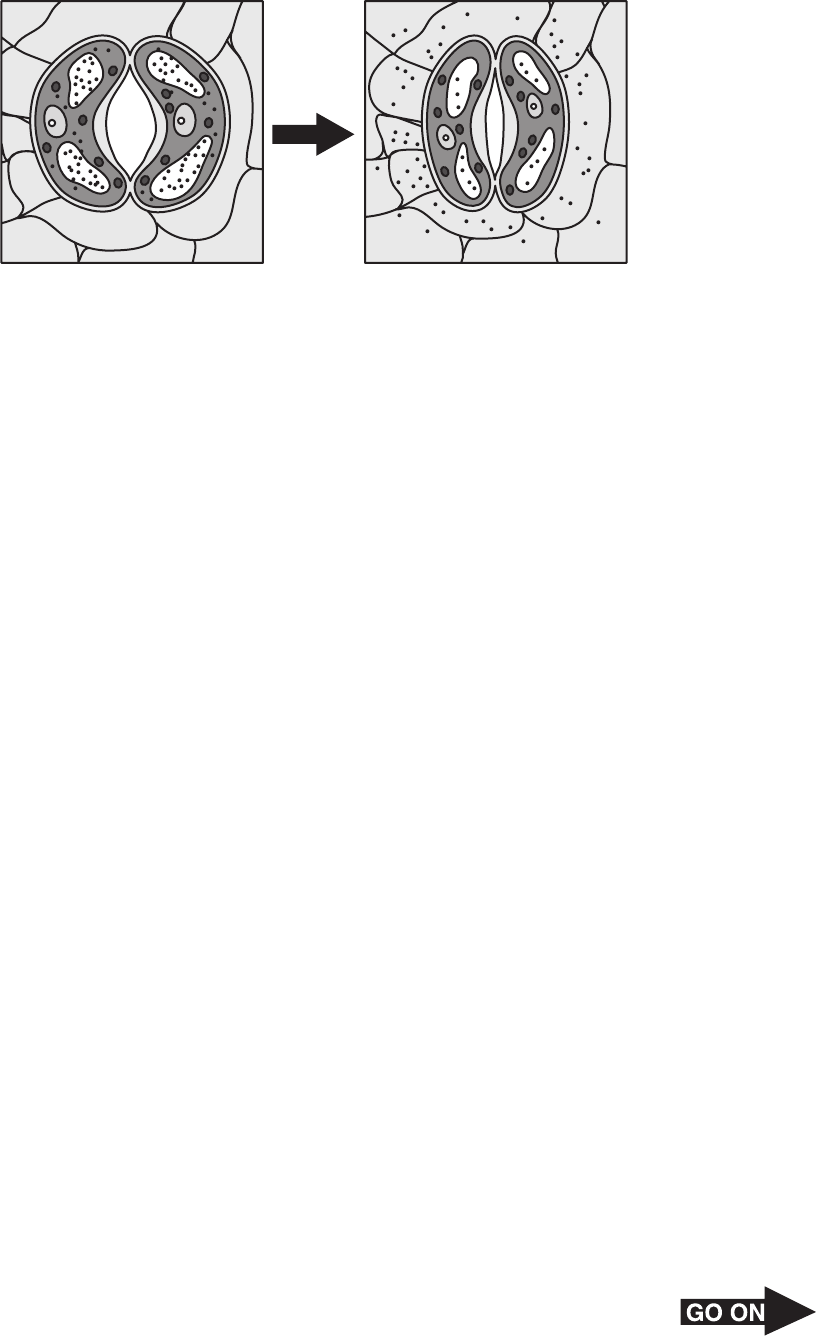
Page 18
23 Structures represented in the illustration below are found in the lower epidermis of a plant
leaf. The illustration at right shows the response to a certain environmental condition.
Normal Conditions Response to a Condition
The response represented in the illustration would most likely be caused by —
A a reduced supply of oxygen
B long periods of rainfall
C high concentrations of glucose
D little available water

Page 19
24 A segment of DNA is represented in the illustration.
How is information for a specific protein carried on the DNA molecule?
F As a sequence of nucleotides
G In the double-helix shape of the condensed chromosome
H In the ratio of adenines to thymines
J As a pattern of phosphates and sugars
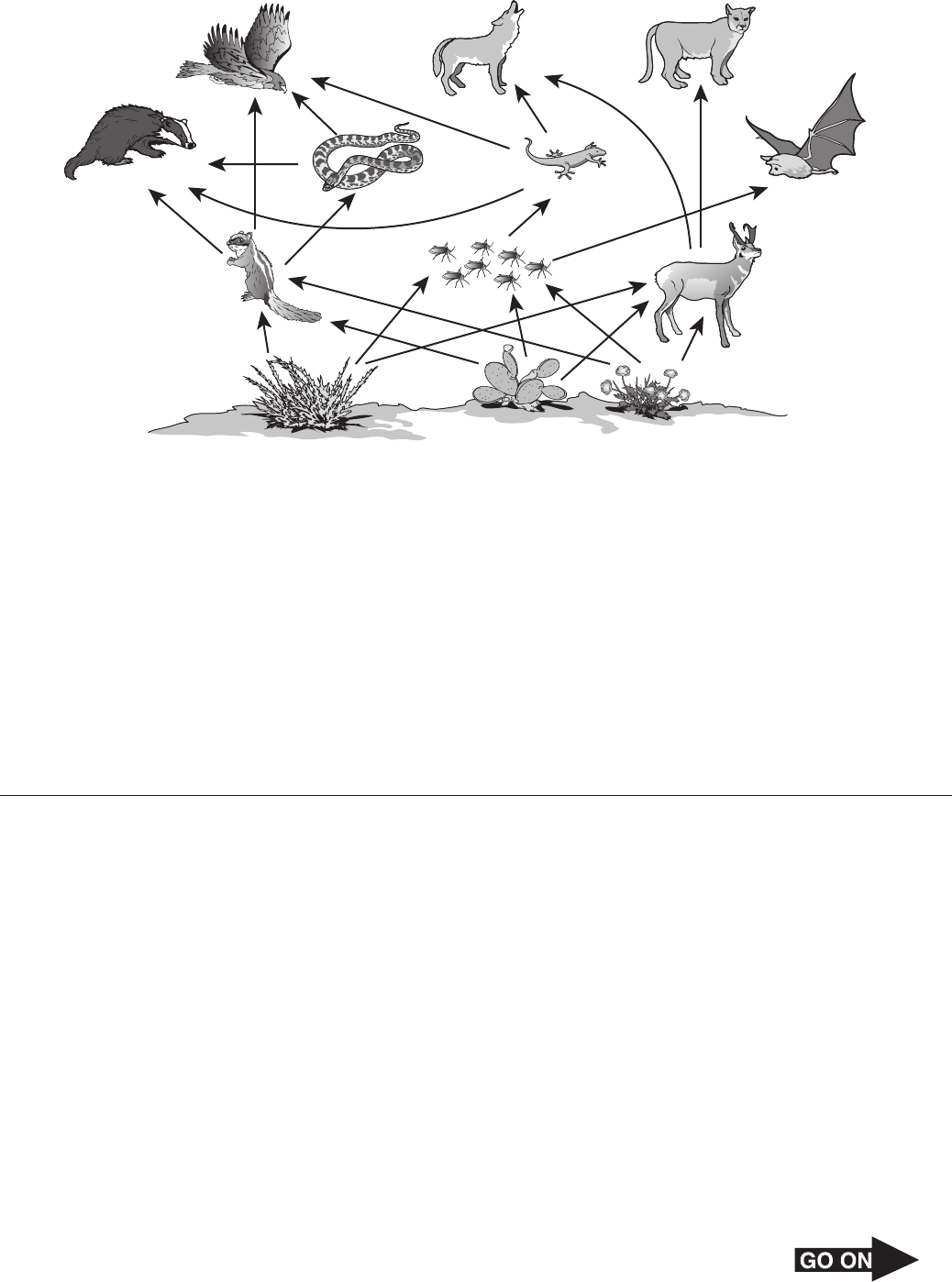
Page 20
25 The food web shows the flow of energy through a sagebrush-steppe ecosystem.
Coyotes
Mountain
lions
Hawks
Pronghorn and
other grazers
Insects
Ground
squirrels
Desert
wildflowers
Prickly pear
cacti
Sagebrush
and rabbitbrush
Bats
Badgers
Lizards and
small reptiles
Snakes
Which of these organisms are in a trophic level that receives a larger percentage of the
energy captured by the producers than the percentage received at the bats’ trophic level?
A Mountain lions
B Snakes
C Hawks
D Ground squirrels
26 Fireflies emit light. The production of light by an organism is called bioluminescence. To
generate visible light, cells in a firefly’s tail produce thousands of luciferase enzymes.
Luciferase binds to a chemical called luciferin. Once bound, the luciferase enzyme speeds up
a chemical reaction that combines an oxygen molecule and luciferin to produce oxyluciferin.
This reaction requires energy and releases light. Which of the following best describes how
the luciferase enzyme speeds up the chemical reaction?
F Luciferase increases the amount of time the light is visible.
G Luciferase decreases the amount of energy required for the reaction to start.
H Luciferase increases the number of sites on luciferin that must bind to oxygen.
J Luciferase decreases the temperature of the environment inside the body of the firefly.

Page 21
27 An analysis of DNA and RNA sequences can be used to classify organisms. A dendrogram,
such as the one shown below, is based on molecular data. It can be used to represent
evolutionary relationships within a group of organisms that are hypothesized to have
descended from a common ancestor.
Brown bear
Sun bear
Spectacled bear
Giant panda
Lesser panda
Raccoon
Dog
100 80 60 40 20 0
Millions of Years Ago
Which statement is best supported by the information in this dendrogram?
A Lesser pandas are more genetically similar to giant pandas than they are to raccoons.
B Brown bears are more genetically similar to giant pandas than they are to sun bears.
C Lesser pandas are more genetically similar to raccoons than they are to giant pandas.
D The bear species are all more genetically similar to dogs than they are to giant pandas.
28 Facial dimples and free earlobes are both considered dominant human traits. What are the
expected phenotypes of the offspring of a female with dimples and free earlobes (DDFf) and a
male with no dimples and attached earlobes (ddff)?
F 50% with dimples and free earlobes and 50% with dimples and attached earlobes
G 50% with dimples and free earlobes and 50% with no dimples and attached earlobes
H 75% with dimples and free earlobes and 25% with no dimples and attached earlobes
J 75% with dimples and attached earlobes and 25% with no dimples and free earlobes

Page 22
29 Adult mountain lions (Puma concolor) are almost 2 meters long. They have a black spot over
each eye. The common names used throughout the United States for this species are listed
below.
• Mountain lion
• Cougar
• Puma
• Panther
• Yuma puma
• Florida panther
• Eastern cougar
• Wisconsin puma
• Texas panther
Common Names for
Puma concolor
Why is it best for scientists to use the name from the standardized taxonomic system?
A The standardized name differentiates mountain lions and pumas.
B The standardized name is less descriptive of the animal that has been observed.
C Communication with other scientists about mountain lions will be reduced.
D All scientists will be using one name for mountain lions.
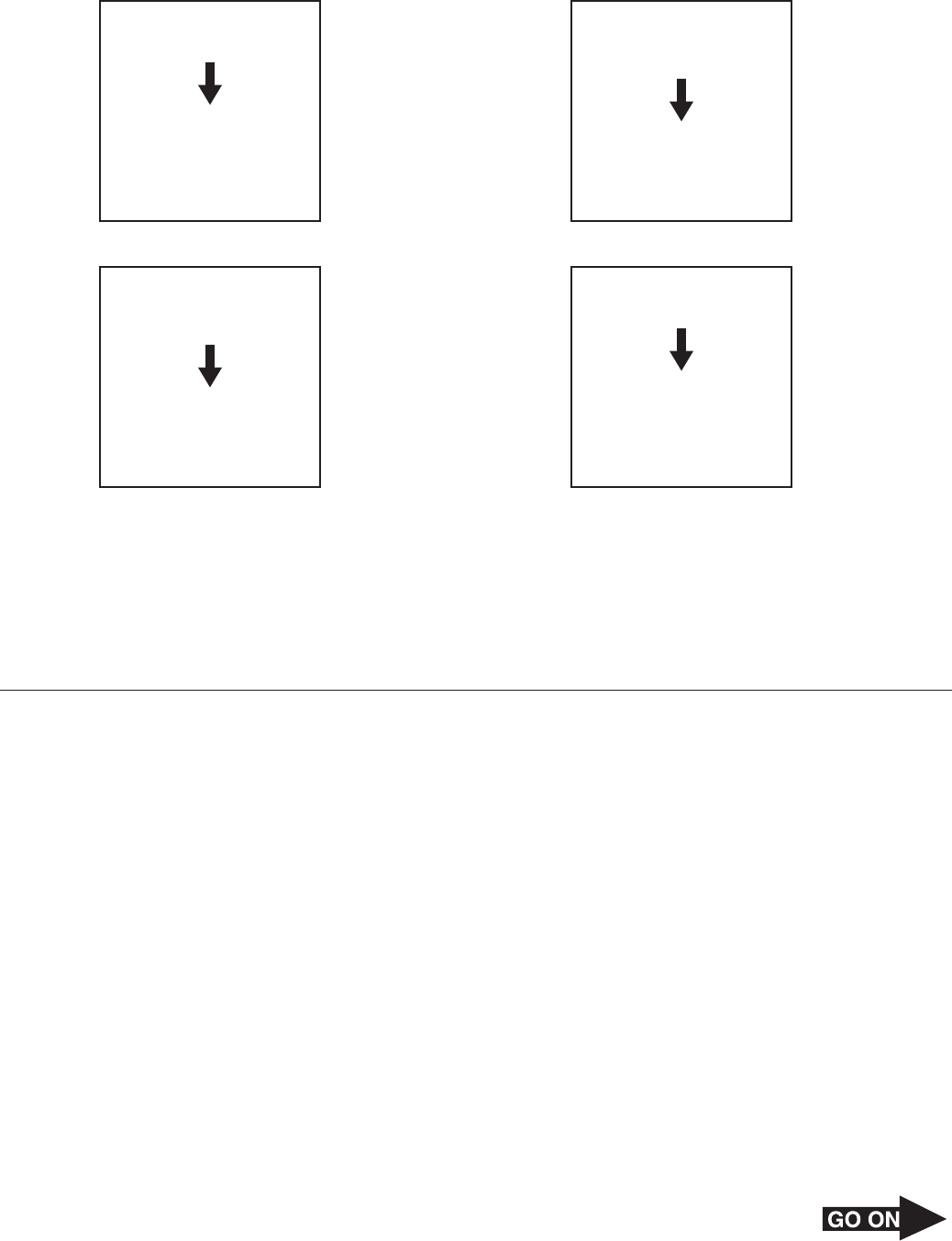
Page 23
30 The internal transport of water and minerals in plants requires that two systems work
together. Which diagram correctly describes how the two systems accomplish this?
F
Transport through
the shoot system by
vascular tissue and
stomata in leaf
tissue
Absorption through
the root system
G
Transport of minerals
through phloem to
leaves in the stem
system
Exchange of minerals
for water in the root
system
H
Sweating into the
soil by the root
system
Transpiration by the
guard-cell and leaf
systems
J
Transport through
the meristematic
system
Absorption of water
by the leaf system
31 At birth Himalayan rabbits are usually white over their entire bodies. But when parts of their
bodies reach temperatures below 35°C, a pigment that causes these parts to turn black is
produced. Which of the following is most likely the cause of this phenomenon?
A Poor blood circulation
B Infection caused by cold temperatures
C Gene expression that is regulated by temperature
D A trait that is both sex-linked and hormone-dependent
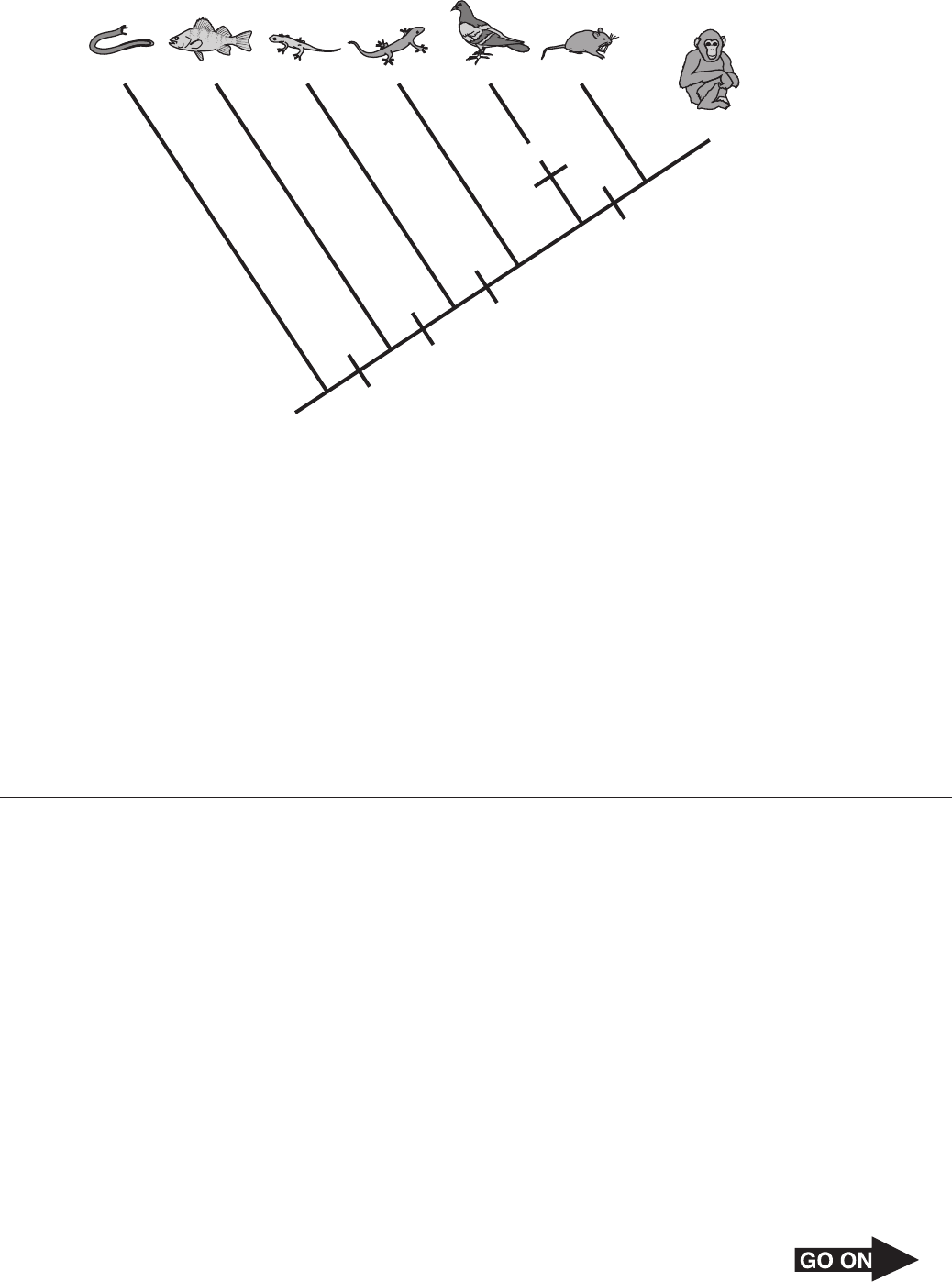
Page 24
32 A cladogram is shown below.
Jaws
Hagfish Perch Salamander Lizard Pigeon Mouse
Chimpanzee
Lungs
Claws or nails
Fur, mammary glands
Feathers
All the animals to the right of the hagfish would have the common characteristic of —
F fur
G claws or nails
H lungs
J jaws
33 The differences between two molecules include the type of sugar that forms a section of the
molecules and the identity of one of the four nitrogenous bases that make up another section
of the molecules. These two molecules are —
A proteins
B lipids
C nucleic acids
D complex carbohydrates

Page 25
34 Plants have developed many methods of seed dispersal. The table below shows seeds of two
different plants.
Milkweed
Dandelion
0.00588
0.0026
Plant Mass of Seed (g) Seed Shape
How has the seed dispersal method developed by these plants given them a reproductive
advantage?
F The method ensures that offspring will be dispersed and reduces competition for
resources.
G The method reduces the chance that herbivores will consume the seeds.
H The method lengthens the life cycle of each of these plants.
J The method reduces the plants’ need for water and other nutrients.

Page 26
35 The table below lists the types of white blood cells found in humans, indicates how abundant
they are, and describes their functions.
Type
Percentage of
Total White
Blood Cell Count
Function
Basophils
<1% Involved in inflammation
Eosinophils
1%–6% Involved in allergic responses
Lymphocytes
25%–33% Produce antibodies against toxins
Monocytes
2%–10% Remove foreign particles and prevent germ invasion
Neutrophils
54%–62% Attack and engulf microorganisms
The two most abundant types of white blood cells may both be involved in a response to
which of these?
A Injury
B Heat
C Allergens
D Bacterial infection
36 A science class is planning a field trip to a local farm that has a large pond. Which of the
following lists the order of biological organization from smallest to largest that the students
can expect to find at the pond?
F Organism, community, population, ecosystem
G Organism, population, community, ecosystem
H Population, organism, community, ecosystem
J Population, organism, ecosystem, community
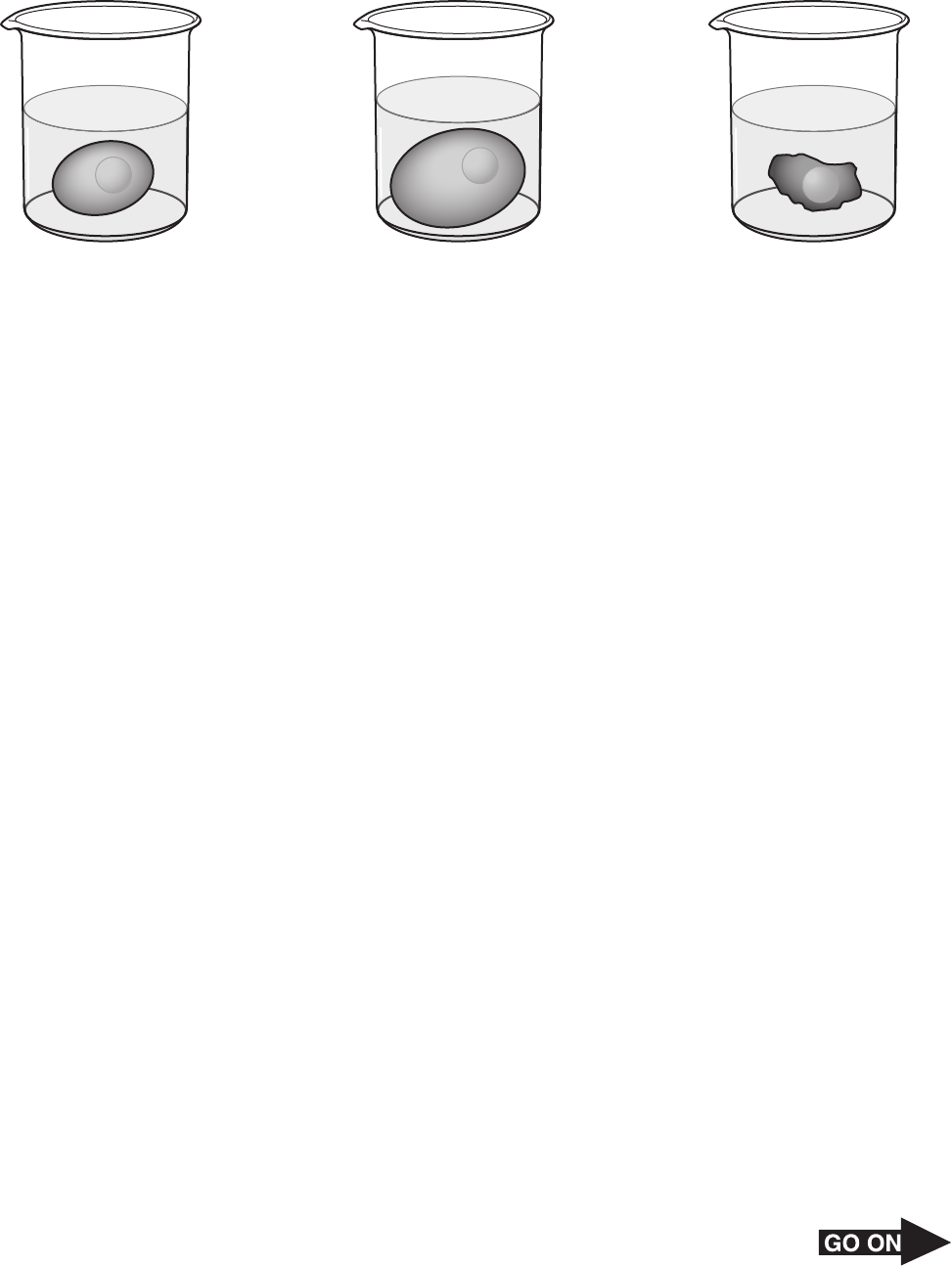
Page 27
37 Some students used vinegar to dissolve away the shells of three eggs and used these eggs as
models of human red blood cells. The students observed the changes in the eggs when they
were placed in different solutions.
300 mL of
pure water
300 mL of
corn syrup solution
300 mL of
5% vinegar solution
Red Blood Cell Model in Different Solutions
Which statement best describes the role of the cell membrane in this model?
A The cell membrane is an impermeable barrier that prevents water from entering the
cell.
B The cell membrane allows solutes to enter the cell, which causes the cell to shrink.
C The cell membrane allows water to enter and leave the cell.
D The cell membrane removes solutes from the environment.
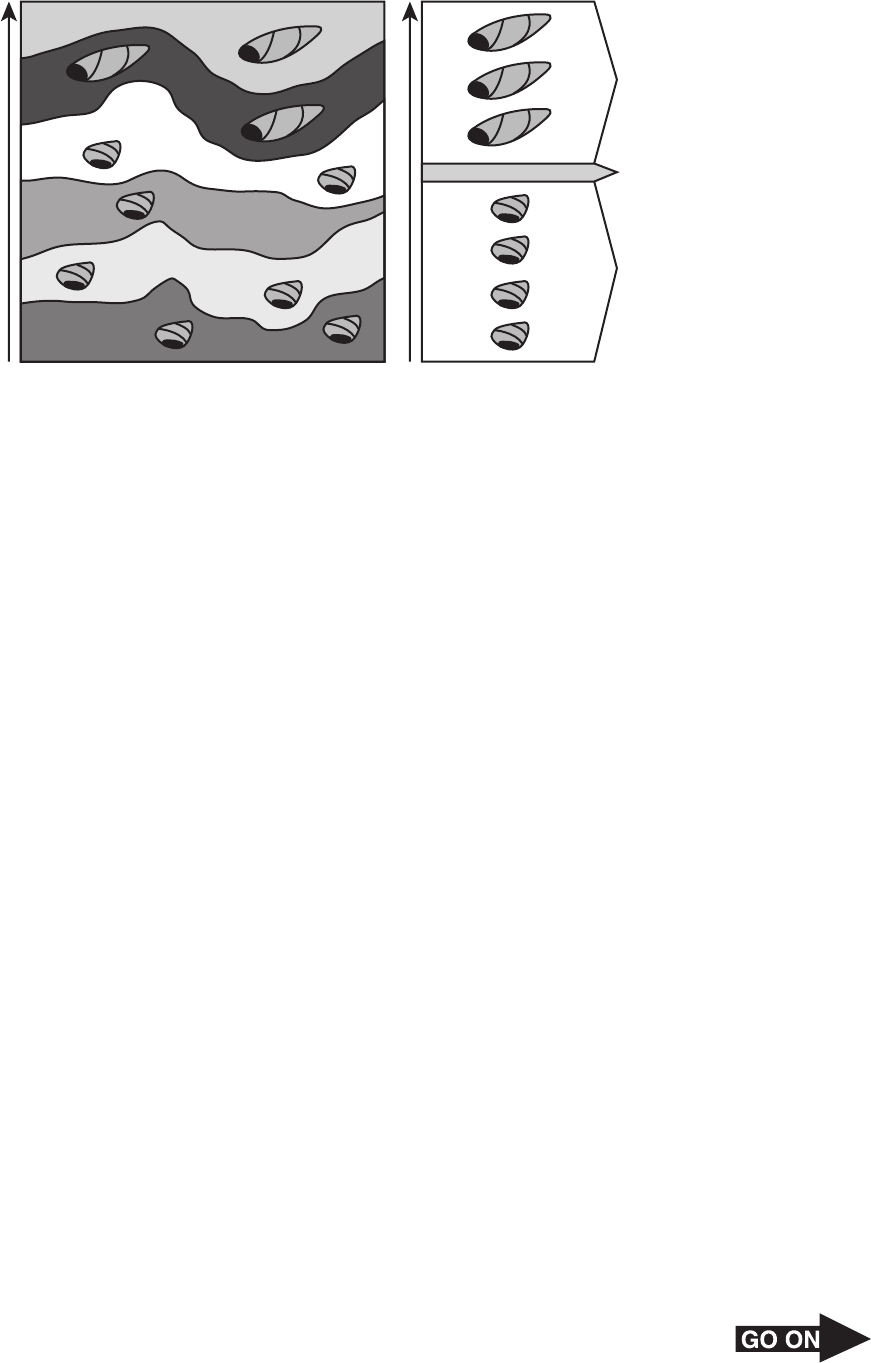
Page 28
38 This diagram of the fossil record represents changes in mollusks over millions of years.
Time
Stasis
Stasis
Rapid change
Mollusks in the Fossil Record
How can the pattern of change in the fossil record best be explained?
F The mollusks were well adapted to their stable environment. A large, sudden change
occurred in their environment. After the change the mollusks with the bigger shells
were better adapted for the new environment.
G The mollusks were well adapted to their stable environment. The mollusks hybridized
with a smaller species of mollusk. A new species of mollusk with a bigger shell resulted.
H The mollusks were not well adapted to their environment. The length of the mollusks’
shells changed gradually over time. The mollusks in the original population that had
small shells died over a period of many years.
J The mollusks were well adapted to their environment. Humans introduced a new
species of mollusk that was not adapted to this environment. The introduced mollusk
outcompeted the native mollusk species.

Page 29
39 Animal body systems often coordinate their actions to carry out specific functions for the
whole animal. Which of these correctly describes the interaction of two biological systems for
a specific purpose in the human body?
A
The nervous system
secretes hormones
that cause smooth
and skeletal muscles
to contract.
The endocrine
system responds to
shivering by causing
sweat glands to
produce sweat.
Temperature Regulation
B
As parts of the
integumentary
system, skin and
nostril hairs help
keep invading
pathogens out.
Within the immune
system, antibodies
are produced by
B lymphocytes to
defend against
invaders that enter.
Infection Defense
C
The digestive
system transports
digested materials
to areas of the
body where they
are needed.
The circulatory
system breaks
down food into
usable materials
mechanically
and chemically.
Nutrient Absorption
D
The endocrine
system produces
sex hormones
(or pheromones)
for the animal.
The reproductive
system controls the
endocrine system
by regulating
hormone levels in
the bloodstream.
Reproduction
40 A student is asked to draw a food web in which the same organism is a primary consumer as
well as a secondary consumer. How should the organism be represented in the food web?
F The organism must have an arrow pointing from it to a tertiary consumer and another
arrow pointing from it to a decomposer.
G The organism must have an arrow pointing from it to a secondary consumer and
another arrow pointing to it from the top predator.
H The organism must have an arrow pointing to it from a producer and another arrow
pointing to it from a primary consumer.
J The organism must have an arrow pointing from it to a primary consumer and another
arrow pointing away from it to a decomposer.
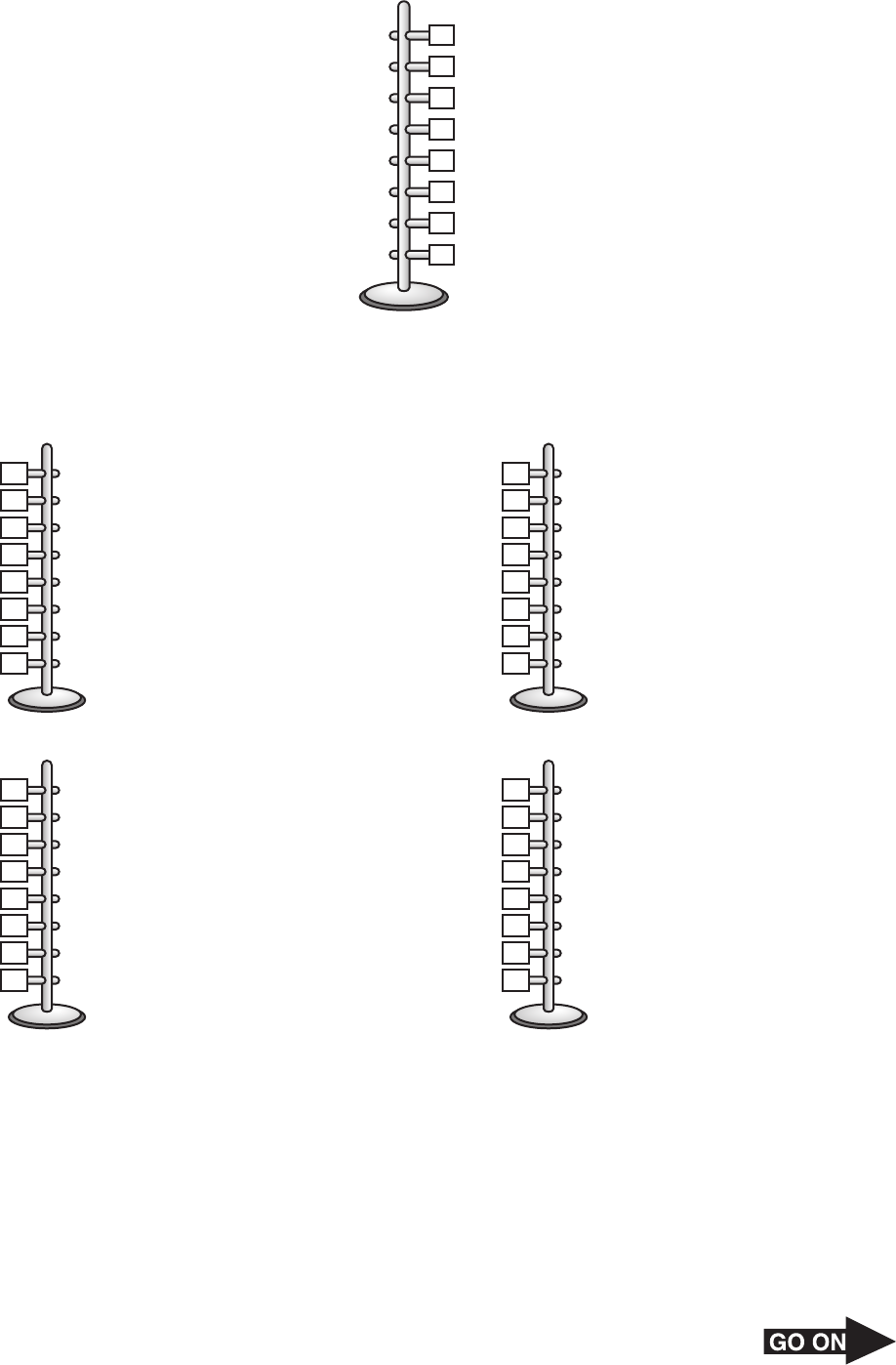
Page 30
41 A student builds a model of a DNA strand.
C
C
T
A
C
C
G
A
Which of these models of a DNA strand shows bases that are complementary to the ones on
the student’s DNA model?
A
C
C
A
G
C
C
A
T
B
G
G
A
U
G
G
C
U
C
G
G
A
A
G
G
C
T
D
G
G
A
T
G
G
C
T

Page 31
42 Bats eat insects that damage crops and mosquitoes that are vectors for disease. One million
bats can eat several tons of insects per night, saving billions of dollars in pesticides yearly.
Agricultural and public health scientists are concerned about the spread of white-nose
syndrome (WNS). WNS is a result of a fungus that can infect cave-dwelling bats. While bats
hibernate during winter months, the fungus covers the bats’ face and wings. WNS has a near
100% mortality rate, and 5.7 million bats have died since the discovery of the fungus in 2006.
Many scientists are searching for ways to protect these bats. The relationship between this
fungus and bats can best be defined as —
F commensal, because the bats provide a surface for the fungus to grow
G parasitic, because the fungus obtains nutrients and shelter from the bats
H competitive, because both organisms use caves as shelter during the winter
J mutualistic, because the relationship involves two distinct species living together

Page 32
43 Three species of lizards of the genus Gallotia are found on the Canary Islands, a chain of
seven volcanic islands off the west coast of Africa. The easternmost island, Lanzarote, is the
oldest, while the westernmost island, El Hierro, is the youngest. The distribution of lizard
species is shown on the map below.
N
E
W
S
100 km
La Palma
El Hierro
Spain
Atlas
Mountains
Africa
Atlantic Ocean
Canary
Archipelago
Africa
South
Atlas Fault
La Gomera
Tenerife
Gran
Canaria
Lanzarote
Gallotia galloti
Gallotia stehlini
Gallotia atlantica
Fuerteventura
Distribution of Gallotia Lizard Species
on the Canary Islands
KEY
Which statement about the ancestry of the lizards from the genus Gallotia is best supported
by this information?
A The common ancestor of the lizards first colonized the island of El Hierro.
B The ancestors of each species came from different continents at different times.
C The common ancestor of the lizards probably came from Africa.
D The ancestors of each species evolved in Spain and were brought to the islands at the
same time.
44 Human body cells each have 46 chromosomes in their nuclei. Meiosis is necessary in order to
ensure that each gamete produced in the human body has —
F 12 chromosomes
G 23 chromosomes
H 46 chromosomes
J 92 chromosomes

Page 33
45 How do an increase in the organic matter in soil and an increase in soil depth affect the
population of plants in an area?
A Larger plants become the dominant organisms.
B Mosses replace flowering plants.
C Nitrogen-fixing bacteria kill young trees.
D Grasses become diseased.
46 Some students used information they gathered from lab investigations to prepare a table.
They entered the table in their lab notebooks.
Cell 1
Cell 2
Is smaller than 5 micrometers Is larger than 10 micrometers
Does not have a nucleus Has a membrane-bound nucleus
Does not have
organelles
membrane-bound Has membrane-bound organelles
Has circular DNA
Has linear DNA
Which of these correctly identifies the two cells described in the table?
F Cell 1 is eukaryotic, and Cell 2 is prokaryotic.
G Cell 1 is prokaryotic, and Cell 2 is eukaryotic.
H Both Cell 1 and Cell 2 are eukaryotic.
J Both Cell 1 and Cell 2 are prokaryotic.
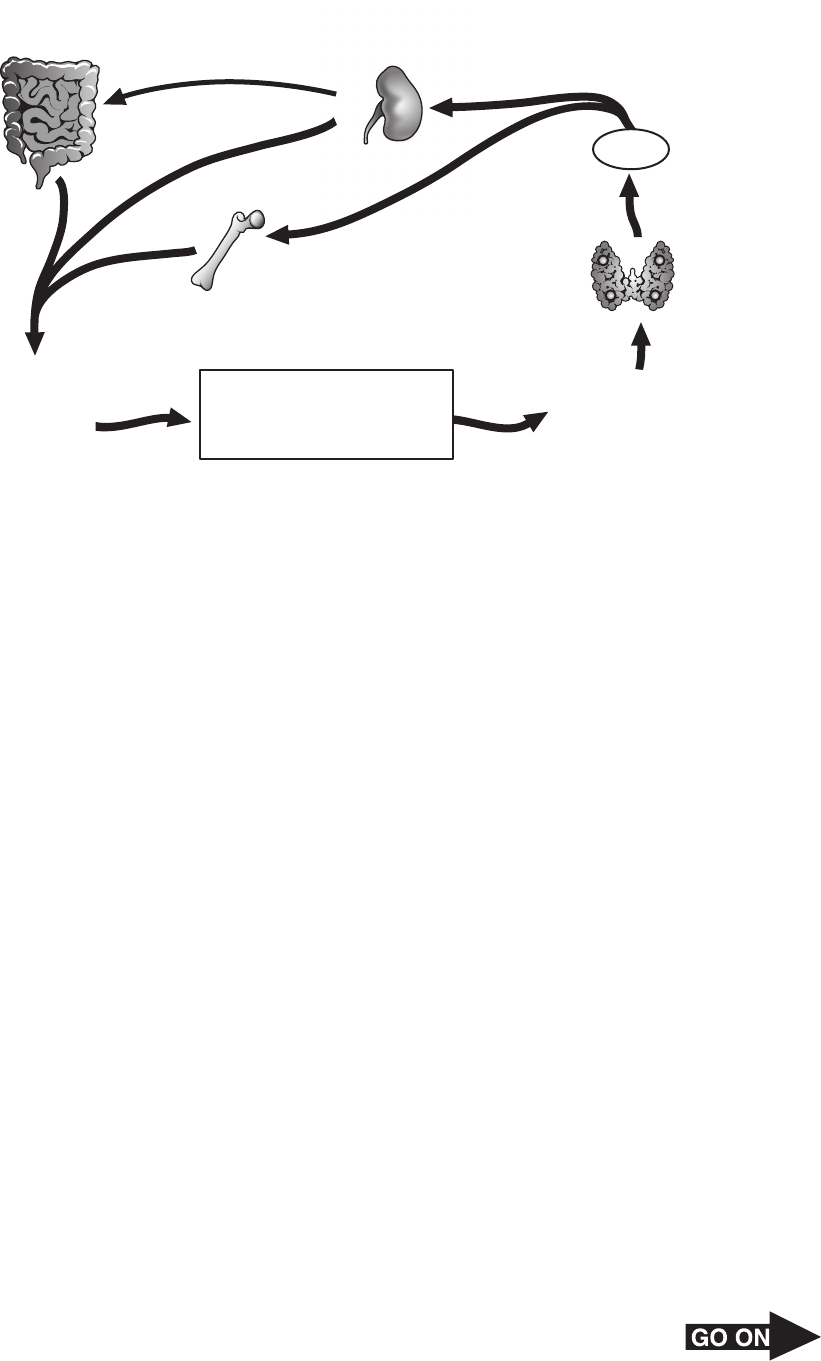
Page 34
47 The diagram shows the internal feedback mechanism that maintains blood-calcium (Ca
2+
)
homeostasis.
Increases Ca
2+
reabsorption
in intestines
Active
vitamin D
Stimulates
Ca
2+
reabsorption
in kidneys
PTH
Stimulus:
Falling blood
Ca
2+
level
Homeostasis:
Blood Ca
2+
level
(about 10 mg/100 mL)
Blood Ca
2+
level rises
Stimulates
Ca
2+
release
from bones
Parathyroid
gland
(behind thyroid)
Releases
parathyroid
hormone
If a person has a blood-calcium (Ca
2+
) level of 8 mg/100 mL of blood, which of the following
mechanisms does the body use to maintain blood-calcium homeostasis?
A The kidneys take up more Ca
2+
and release vitamin D.
B The bones release Ca
2+
.
C The intestines increase reabsorption of Ca
2+
.
D All of the above

Page 35
48 In dry desert areas poor drainage can lead to a buildup of salt in water supplies. A student
performed an investigation to study the effects of salinity on the germination rates of seeds.
The student placed seeds in several solutions containing 0% to 3% salt. The length of the
radicle, which is the root of the germinating seed, ranged from 49 mm in the 0% salt solution
to 0 mm in the 3% salt solution. The data from this investigation suggest that increased
salinity in more areas may lead to a decrease in which of the following?
F Air pollution
G Food production
H Oceanic evaporation
J Nonrenewable resources
49 In the 1960s the molecular biologist George Streisinger developed the strand-slippage
hypothesis. Streisinger noticed that mutations occurred in areas of DNA that contained many
repeated sequences. When a strand-slippage error occurs, an insertion mutation can result.
How does the insertion mutation affect the DNA?
A Nitrogenous bases are added.
B Nitrogenous bases are exchanged.
C Nitrogenous bases are damaged.
D Nitrogenous bases are deleted.

Page 36
50 H1N1 flu is a highly contagious viral infection caused by the influenza A (H1N1) virus. The
symptoms of H1N1 flu are listed in the box below. An antiviral agent administered within
48 hours of the appearance of symptoms can reduce the severity of the illness.
• Acute respiratory illness
• Fever
• Cough
• Sore throat
• Body aches
• Headaches
• Chills and fatigue
• Diarrhea and vomiting
H1N1 Flu Symptoms
Why is it important to administer an antiviral agent to an infected person within 48 hours of
the appearance of symptoms?
F The H1N1 virus is dormant in cells.
G The H1N1 virus replicates quickly.
H The H1N1 virus does not mutate.
J The H1N1 virus is transmitted through a vector host, such as a mosquito.
51 Normal fruit flies have brownish-yellow bodies, and this body color is dominant. A mutation
in the gene for body color can produce flies with an ebony body color. A homozygous normal
fruit fly (e
+
e
+
) is crossed with a homozygous ebony fruit fly (ee). What is the predicted
outcome of this genetic cross?
A All the offspring will have ebony bodies.
B Of the offspring, 75% will have brownish-yellow bodies, and 25% will have ebony
bodies.
C All the offspring will have brownish-yellow bodies.
D Of the offspring, 75% will have ebony bodies, and 25% will have brownish-yellow
bodies.

Page 37
52 Scientists can bioengineer skin in a laboratory to treat severe burns and other types of skin
injuries. This bioengineered tissue is grown from living cells. The cellular process that enables
the cells to grow and develop into tissue is —
F conjugation
G meiosis
H budding
J mitosis
53 The diagram shows the reproductive system of a plant.
Anther
Filament
Ovule
Ovary
Style
Stigma
Which of the following best describes the interaction that occurs between a plant’s
reproductive parts during self-fertilization?
A Pollen is released from the anther and is transferred to the stigma. A pollen tube forms
and grows through the style. The pollen tube reaches the filament, where the sperm
fertilizes the egg.
B Pollen moves from the ovule up through the style and is released from the stigma. The
pollen is transferred to the anther, where the sperm fertilizes the egg.
C Pollen is released from the anther and is transferred to the stigma. A pollen tube forms
and grows through the style. The pollen tube reaches an ovule within the ovary, where
the sperm fertilizes the egg.
D Pollen is released from the stigma and is transferred to the anther. A pollen tube grows
down from the anther through the filament and fuses with the ovule, where the sperm
fertilizes the egg.

Page 38
54 The diagram shows the flow of organic molecules through an ecosystem. One process that
occurs in this ecosystem is labeled X, and another process that occurs is labeled Y.
CO
2
Carbon dioxide
Microorganisms in soil
X
X
X
Y
Y
Y
Y
P
h
o
t
o
s
y
n
t
h
e
s
i
s
Which two processes are identified by the labels X and Y?
F X: Respiration
Y: Predation
G X: Adaptation
Y: Decomposition
H X: Fermentation
Y: Nitrogen fixation
J X: Decomposition
Y: Respiration
BE SURE YOU HAVE RECORDED ALL OF YOUR ANSWERS
ON THE ANSWER DOCUMENT.
STOP

STAAR
Biology
May 2015
TX868596 1 2 3 4 5 A B C D E Printed in the USA DPSS/ISD7232
